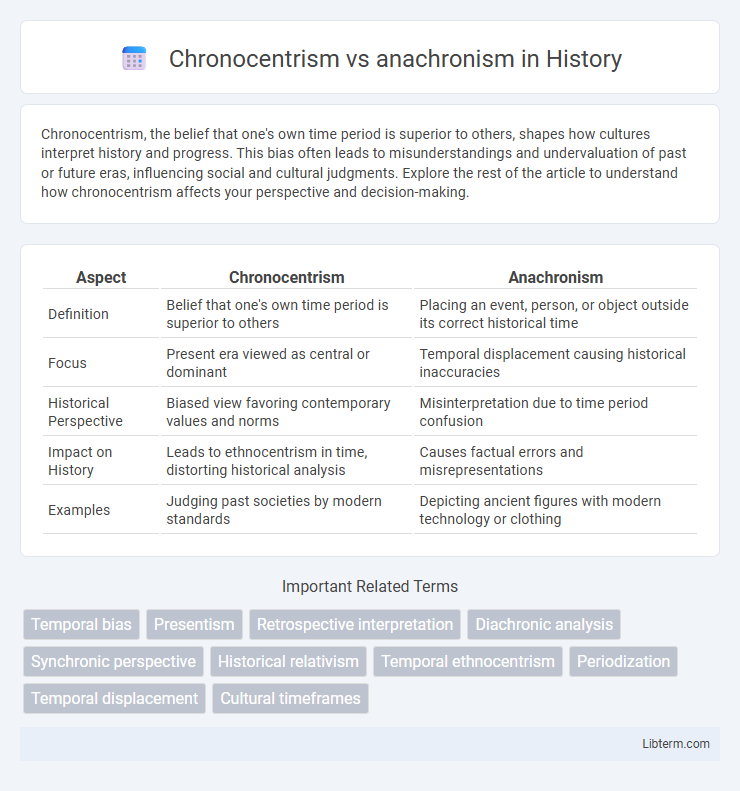Chronocentrism, the belief that one's own time period is superior to others, shapes how cultures interpret history and progress. This bias often leads to misunderstandings and undervaluation of past or future eras, influencing social and cultural judgments. Explore the rest of the article to understand how chronocentrism affects your perspective and decision-making.
Table of Comparison
| Aspect | Chronocentrism | Anachronism |
|---|---|---|
| Definition | Belief that one's own time period is superior to others | Placing an event, person, or object outside its correct historical time |
| Focus | Present era viewed as central or dominant | Temporal displacement causing historical inaccuracies |
| Historical Perspective | Biased view favoring contemporary values and norms | Misinterpretation due to time period confusion |
| Impact on History | Leads to ethnocentrism in time, distorting historical analysis | Causes factual errors and misrepresentations |
| Examples | Judging past societies by modern standards | Depicting ancient figures with modern technology or clothing |
Understanding Chronocentrism: Definition and Origins
Chronocentrism refers to the tendency to view past events, cultures, or epochs through the biased lens of contemporary values and norms, often leading to misunderstandings or misinterpretations of historical contexts. The concept originates from social and cultural studies, highlighting how present-day beliefs shape the perception of history and time. Recognizing chronocentrism is crucial for accurate historical analysis, as it challenges anachronistic judgments that impose modern standards on prior periods.
What Is Anachronism? Contexts and Examples
Anachronism refers to the chronological inconsistency where an object, event, or person is placed in a time period to which it does not belong, often creating a historical inaccuracy. Common contexts include literature, film, and art, where modern technology, language, or customs are inaccurately depicted in past eras, such as a character using a smartphone in a story set in the 19th century. Examples of anachronism include a wristwatch in a medieval tale or references to the internet during ancient Rome, highlighting the clash between historical accuracy and creative license.
Chronocentrism in Modern Society
Chronocentrism in modern society manifests as the tendency to view contemporary times as superior and more advanced compared to past eras, often leading to the dismissal of historical contexts and values. This mindset influences cultural attitudes, technological adoption, and social norms by prioritizing present-day perspectives over historical accuracy. Understanding chronocentrism is crucial for addressing biases that affect historiography, cultural heritage preservation, and intergenerational communication.
Anachronism in Literature and Media
Anachronism in literature and media refers to the inclusion of elements, such as objects, language, or customs, that belong to a different historical period than the narrative setting, often disrupting temporal authenticity. This literary device can create intentional contrast or irony, but unintentional anachronisms may undermine historical accuracy, confusing audiences and diminishing credibility. Prominent examples include Shakespeare's use of clock references before mechanical clocks existed and modern films depicting characters with technology or attire absent in the depicted era.
Key Differences between Chronocentrism and Anachronism
Chronocentrism centers on the belief that one's own time period is superior to others, often leading to biased judgments about past or future eras. Anachronism involves placing events, objects, or ideas in a time period where they do not belong, causing historical inaccuracies or distortions. The key difference lies in chronocentrism being an evaluative attitude toward time, while anachronism represents a chronological error or misplacement.
Impacts of Chronocentrism on Historical Analysis
Chronocentrism, the belief that one's own time period is superior, distorts historical analysis by projecting contemporary values and norms onto past events and societies. This bias leads to misinterpretations and undervaluation of historical contexts, hindering accurate understanding of cultural, social, and political developments. Consequences include skewed historiography and a diminished appreciation for the complexity and diversity of human history.
How Anachronism Shapes Cultural Perceptions
Anachronism shapes cultural perceptions by projecting contemporary values and ideas onto historical events, often distorting their original context and significance. This temporal misplacement influences how societies interpret past behaviors, technologies, and social norms, sometimes leading to misunderstandings or idealizations. Recognizing anachronism is essential for historians and cultural analysts to preserve accurate historical narratives and appreciate the evolution of human thought without present-day bias.
Avoiding Chronocentric Bias in Historical Interpretation
Avoiding chronocentric bias in historical interpretation requires recognizing the tendency to judge past events, cultures, or individuals based on contemporary values and knowledge. Historians must contextualize actions and beliefs within their specific time periods to prevent anachronistic assessments that distort historical accuracy. Employing primary sources, cultural relativism, and multidisciplinary approaches enhances objective understanding while mitigating present-day value imposition on historical narratives.
Recognizing and Addressing Anachronism in Research
Recognizing and addressing anachronism in research requires a critical understanding of the historical context to avoid projecting contemporary values onto past events, a bias known as chronocentrism. Scholars must carefully analyze primary sources and distinguish between present-day interpretations and the original cultural, social, or political conditions of the era studied. Employing interdisciplinary methodologies and historiographical awareness enhances the accuracy of historical representation, mitigating the distortion caused by anachronistic assumptions.
Chronocentrism vs Anachronism: Why the Distinction Matters
Chronocentrism refers to the tendency to view the present era as the most significant or superior, often leading to biased interpretations of past events. Anachronism involves attributing modern values or concepts to historical contexts where they do not belong, distorting accurate understanding. Distinguishing between chronocentrism and anachronism is crucial for historians to avoid presentism and maintain objective analysis of historical periods.
Chronocentrism Infographic

 libterm.com
libterm.com